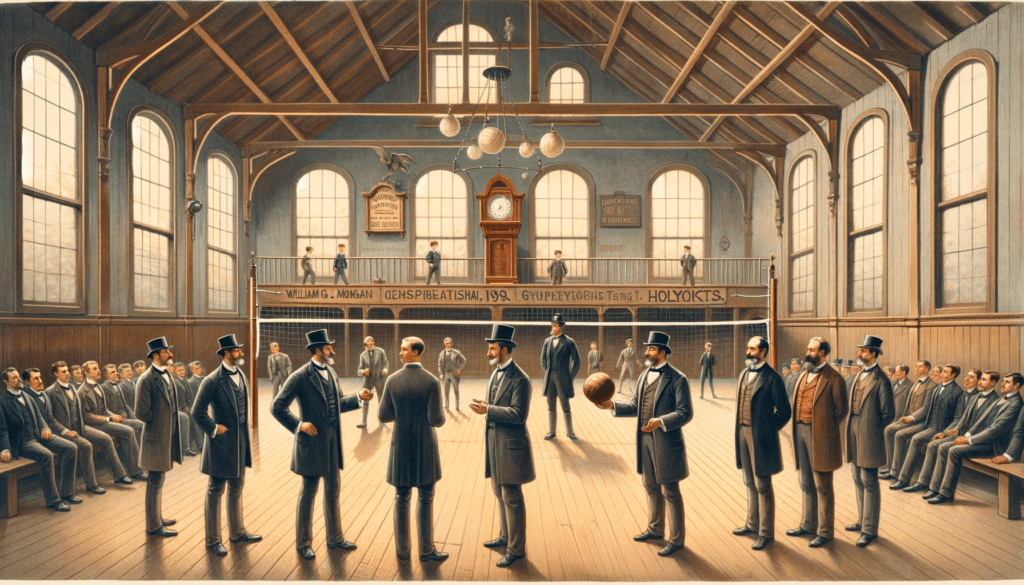Hey, sports enthusiasts! Ever wondered about the origins of volleyball, the thrilling game that combines athleticism and strategy? Let’s take a deep dive into when volleyball was invented and how it evolved from a simple gym activity to a globally celebrated sport. Buckle up for a ride through history, peppered with fun facts and engaging insights!
When Was Volleyball Invented? A Peek into the Past

It all started in 1895 in Holyoke, Massachusetts. William G. Morgan, a young physical education instructor, sought a new sport that would be less intense than basketball but still enjoyable for his class. He blended elements from basketball, baseball, tennis, and handball to create “Mintonette,” the game that would later become volleyball.
The Birthplace of Volleyball: Holyoke, Massachusetts
Holyoke, a vibrant town, played a crucial role in the birth of volleyball. The game was initially designed for businessmen as a gentle, non-contact sport. Morgan’s idea was to provide a recreational activity that was engaging yet not too strenuous.
The Evolution of Volleyball: From Mintonette to Modern-Day

As the game gained popularity, it underwent significant changes. In 1896, during a demonstration at the International YMCA Training School, the name “volleyball” was suggested because of the volleying nature of play.
Rules of the Game: Setting Standards
The original rules of the game were quite different from what we know today. The net was set at 6 feet 6 inches – just slightly higher than an average man’s head. Over time, the rules of the game evolved, incorporating aspects like the row attacker and setting and spiking, adding more dynamism and excitement to the sport.
Volleyball for Men and Women: A Sport for All
Volleyball quickly became a game loved by both men and women. Its appeal as a non-contact, strategic game made it popular across genders. The inclusivity of volleyball is one of its most endearing aspects.
National and International Recognition: Spreading the Volleyball Fever
The growth of volleyball was exponential. By 1916, the game had caught the attention of the National Collegiate Athletic Association (NCAA), which introduced it into their competitive sports programs. This move was pivotal in standardizing rules and promoting the game at a collegiate level.
Volleyball’s Olympic Debut: A Global Stage
One of the most significant milestones in volleyball history was when volleyball was introduced to the Olympic Games in 1964. This inclusion elevated the sport to an international level, showcasing the skill and athleticism of volleyball players from around the world.
Fédération Internationale de Volleyball (FIVB): The Governing Body
The formation of the Fédération Internationale de Volleyball (FIVB) in 1947 was another crucial development. As the sport’s governing body, the FIVB played a vital role in standardizing rules and organizing international competitions, including the prestigious national championships.
The Evolution of Beach Volleyball: Sand and Spikes

While indoor volleyball was gaining popularity, another variant was emerging – beach volleyball. Originating on the sunny beaches of California, beach volleyball added a new dimension to the game, combining the thrill of volleyball with a relaxed beach setting.
The Game Today: Volleyball’s Current Status
Today, volleyball is a dynamic sport, loved by millions around the world. Whether it’s the excitement of a powerful spike, the strategy behind a well-placed set, or the thrill of a close match, volleyball offers something for everyone.
Conclusion: Volleyball’s Enduring Legacy
From its humble beginnings in Holyoke, Massachusetts, to becoming a beloved Olympic sport, volleyball’s journey is a testament to its enduring appeal. The game has evolved, but the essence of what William G. Morgan created remains – a sport that is enjoyable, inclusive, and endlessly fascinating.
FAQs
The term “volleyball” was coined in 1896, evolving from the original game “Mintonette.”
Volleyball was invented in 1895 by William G. Morgan, a physical education director.
Beach volleyball originated in the 1920s on the sunny beaches of California.
Indoor volleyball was invented in 1895, simultaneously with the original volleyball game.
Sitting volleyball emerged in the Netherlands in 1956 as a rehabilitation sport.
Volleyball was invented in February 1895, in Holyoke, Massachusetts.
The volleyball spike was developed early in the 20th century, enhancing the game’s dynamics.




